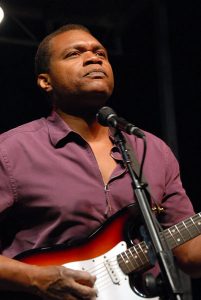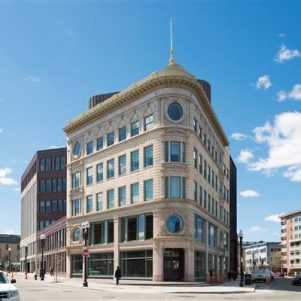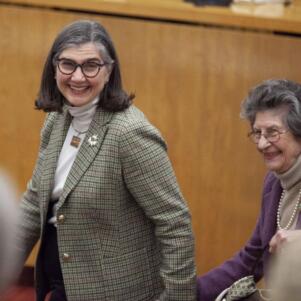The BLOG: Music
The Soul of Robert Cray’s ‘Lowdown and Funky’ Journey
James P. Freeman | May 28, 2017
Thirty years ago, next month, Robert Cray appeared on the cover of Rolling Stone with the headline announcing: “The Blues are Back and He’s the Boss.” Last month, Cray released a new album, Robert Cray & Hi Rhythm, which should garner a new headline: “Soul Is Back and He’s the Boss.” It marks an extraordinary musical journey.
During the Eighties and Nineties, Cray — with The Fabulous Thunderbirds and Stevie Ray Vaughn – led a blues revival that paid homage to the likes of B.B. King and Albert Collins while adding a pop sensibility. Newly modernized and suddenly accessible, the music moved from the basements of dark clubs and back rooms of deserted record shops to the mainstream.
As a result, Cray’s 1986 release, the brooding and sizzling Strong Persuader, went gold (“a feat virtually unheard-of for a blues album,” said Rolling Stone), peaked at No. 13 on the Billboard charts, and yielded a Top-Forty hit with “Smoking Gun.” The crossover single found heavy rotation on radio and the then-new medium of MTV, introducing Cray and his music to a new generation of listeners. And importantly, along with state-of-the-art videos for the tracks “Right Next Door (Because of Me)” and “Nothin’ But A Woman,” a new generation of viewers.
Blues had a new voice and a new face that was immediately attractive, affable, and approachable. A singer, songwriter and guitarist that appealed to both sexes, harnessing a distinctive new sound: vocals of honey and guitars of Hendrix-induced tones. In early 1988, Cray received a Grammy Award for Strong Persuader, as “Best Contemporary Blues Recording.” And, in 1989, Rolling Stone voted the album No. 42 in its survey of 100 best albums of the 1980s.
Cray was ubiquitous. For his first national television appearance, he appeared on NBC’s Late Night with David Letterman, in November 1986. He opened for Eric Clapton in the spring of 1987. He played a support role in the 1987 documentary showcasing Chuck Berry, Hail! Hail! Rock ‘n’ Roll. He toured extensively across the globe with his own band (locally, he made his debut at the world-famous Cape Cod Melody Tent in the summer of 1987) and released two more albums of critical and popular acclaim (1988’s Don’t Be Afraid of the Dark and 1990’s Midnight Stroll). At the close of the decade, Eric Clapton’s praiseworthy observation of the phenom was accurate. “Robert Cray was an intelligent young black man who wasn’t interested in making contemporary black music. He was more interested in preserving the blues form and enlarging on it.”

For many, though, the exuberance of that time and excitement of newly-crafted blues ended the day Stevie Ray Vaughn died in a helicopter crash after a concert outside East Troy, Wisconsin, on August 29, 1990. Cray and Clapton were among the performers at the show at the Alpine Valley Musical Theater.
Perhaps intuitively, Cray rightly sensed a changing landscape. The next generation would be entertained by hip hop and grunge and electronica; MTV would become reality TV. And perhaps instinctively, Cray believed his music needed to evolve, too (he would turn 40 in 1993). Thus, the ensuing years meant that while blues would be the foundation of his musical expression, it wouldn’t be the forefront. Subsequent albums would fuse a combustible mix of rock, jazz, gospel, R&B, Latin beats, and funk. And, notably, soul.
From the radiating bustle of Los Angeles loomed the river banks of Memphis.
The migration was natural, the shift subtle as soul music was a logical progression. (Cray was born in Georgia, while his father was stationed at Fort Benning; by now, he was living in California.) So, “Young Bob” (as he described himself) of Strong Persuader would morph into the “lowdown and funky” (a phrase he used in concert) mature soul of Robert Cray & Hi Rhythm. A Soul Man.
The central figure weaving in and out of Cray’s music is the late O.V. Wright, who blended blues and southern soul, forging a dynamic sound. Cray covered Wright on his first album, Who’s Been Talkin’, from 1980. Wright’s influence is also heard on Cray’s new album, with a version of “You Must Believe in Yourself,” first recorded by Wright on his 1973 album Memphis Unlimited. During an interview for the House of Blues Radio Hour Show in 2001, Cray cited the influence of Wright on his career and his choosing songs to cover. Cray said Wright was the “ultimate soul ballad singer,” and was struck by Wright’s songs that “gradually build up” with drama.
Cray has always been attracted to the Memphis Sound. The Memphis Horns added a soulful, melodic counter balance to Strong Persuader (“I Guess I Showed Her”) and Midnight Stroll (“Consequences” and “Bouncin’ Back”). His own vocal phrasing, at times, nodded to Al Green. And for the first time, in 1997, Cray recorded in Memphis, making Sweet Potato Pie with the Memphis Horns. As Cray’s website concluded, that effort was the band’s “most soulful album to date.”
By 1999, the transition was complete with the release of Take Your Shoes Off. Saturated like a humid August evening with the electric buzz of cicadas, it drips in sounds of 1960s soul, mindful of vintage Stax and Hi masterpieces. Paired up for the first time with producer/musician Steve Jordan and arranger Willie Mitchell, Cray remembers, “that was definitely a soul record.” The smoldering “Love Gone to Waste,” the playful “24-7 Man,” the funky swagger of “Pardon,” and the organ trot of “Living Proof,” confirms he reached full circle. There was still enough of the classic Cray guitar tone — a slightly out of phase, trebly and twangy Stratocaster — and Curtis Mayfield-styled vocals to keep long-time fans content. Ironically, the album won a Grammy for “Best Contemporary Blues Recording.”
Jordan also produced and collaborated on 2001’s Shoulda Been Home and 2014’s In My Soul, as Cray experimented further with sonic idioms, band iterations, and live compilations in between those albums. But as Cray told Blues Blast magazine in 2014, upon reconnecting with Jordan, “Everybody knows that it’s not a strange thing for us to do this type of material, but this record includes more of it than we’ve done in the past. I guess it was just what was in the air at the time. Soul was in the air!” Media were slow to catch on. A Blues Matters! cover story in 2012 was titled “Robert Cray: Nothin’ But the Blues.” Adjusting to the change, the same publication in 2014 wrote a cover story: “Robert Cray: The Soul of the Blues.”
But nothing could have adequately prepared blues and soul aficionados for his 18th studio release, Robert Cray & Hi Rhythm, the full realization of Cray’s soul incarnation and his best and most adventurous work since 2003’s Time Will Tell.
For this project, Cray again teamed with Jordan and headed to Memphis to record with Hi Rhythm, the band that helped create that original, unique sound (think Motown meets Stax meets Chess). The sessions took place at the old Royal Studios, with brothers Reverend Charles Hodges (organ and piano) and Leroy “Flick” Hodges (bass), along with cousin Archie “Hubbie” Turner (keyboards), and the Royal Horns. Jordan helmed the production and played drums. He said the experience “was a soul, rhythm and blues, fantasy camp for us. Those guys have been playing in that room for 50 years.”
While Cray only contributes three tracks, the remaining eight were carefully chosen from the deep well of the Hi Records catalog. The results are an authentic and rugged tribute as Cray pushes new boundaries. Jordan ably anchors the proceedings, allowing Cray to explore and express his staccato guitar chops within drenched organ and brass with new-found freedom. And his vocal interpretations bring life to the ghosts of Otis Redding and Sam Cooke. It is a towering achievement. The collection is a statement: Soul is back!
Among the several highlights: the sweeping climax of opener “The Same Love That Made Me Laugh” (written by Bill Withers); the suggestive strut of “Honey Bad” (penned by Sir Mack Rice, who wrote “Mustang Sally” and co-wrote “Respect Yourself”); the doo-wop bop of “I’m With You (Part 1)” (written by Lowman Pauling).
And then there is the album’s penultimate moment, the staggering “Don’t Steal My Love.” Urgent and cinematic, it could have been the soundtrack for America beset with riots and assassinations in 1968. Against the jagged jabs of a Wurlitzer electric piano and angry wah-wah guitar (played by Tony Joe White who wrote the original version nearly fifty years ago), the pulsating, droning beat boils amid the chaos. Cray’s distorted vocal warns “If you take from me, give something in return, don’t be so cold while my fire burns.” As psychedelic soul, the song could be a metaphor, with “love” the neighborhoods and political leaders shattered by violence. “Don’t take my soul with you,” Cray cries out, just before the heart is stabbed open by a piercing, aching guitar solo, conjuring Hendrix’s wails of late ‘60s anguish. Life fades from the speakers …
It is Cray’s finest performance since “Smoking Gun” and confirms he is boss.
(Robert Cray will be appearing at the Narrows Center for the Arts in Fall River, Massachusetts on Tuesday, May 30 and Calvin Theater in Northampton, Massachusetts on Wednesday, May 31.)
James P. Freeman is an opinion writer for New Boston Post.





